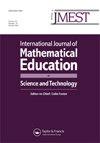Teaching differential equations through modelling: hot water heater
IF 0.6
Q3 EDUCATION & EDUCATIONAL RESEARCH
International Journal of Mathematical Education in Science and Technology
Pub Date : 2023-09-15
DOI:10.1080/0020739x.2023.2249899
引用次数: 0
Abstract
AbstractWe present an example of one of the modelling projects we assign to students in our differential equations classes. Students are asked to determine how to run a cost-efficient hot water heating system. We consider a cylindrical tank filled with water and heated by a heating element immersed in it. Together with students we discuss physical laws governing the process and make assumptions necessary to build a model. One of the goals of the modelling activity is to compute the time needed for water to reach the desired temperature given the power of the heating element and the size of the water tank. Several different scenarios can be discussed. Assuming the cost of heating the water is directly related to the time for which the power is ON, students can choose the most cost-efficient scenario. We provide the description of several modelling activities and obtained results.Keywords: Mathematical modellingordinary differential equationshot water heater Disclosure statementNo potential conflict of interest was reported by the authors.通过建模来教授微分方程:热水器
摘要我们在微分方程课上给学生布置了一个建模项目的例子。学生们被要求确定如何运行一个经济高效的热水加热系统。我们考虑一个装满水的圆柱形水箱,并由浸入其中的加热元件加热。我们与学生一起讨论控制过程的物理定律,并为建立模型做出必要的假设。建模活动的目标之一是在给定加热元件的功率和水箱的大小的情况下计算水达到所需温度所需的时间。可以讨论几种不同的场景。假设加热水的成本与电源打开的时间直接相关,学生可以选择最具成本效益的方案。我们提供了几个建模活动的描述和获得的结果。关键词:数学建模常微分方程shot热水器披露声明作者未报告潜在利益冲突。
本文章由计算机程序翻译,如有差异,请以英文原文为准。
求助全文
约1分钟内获得全文
求助全文
来源期刊

International Journal of Mathematical Education in Science and Technology
EDUCATION & EDUCATIONAL RESEARCH-
CiteScore
3.30
自引率
11.10%
发文量
123
期刊介绍:
Mathematics is pervading every study and technique in our modern world, bringing ever more sharply into focus the responsibilities laid upon those whose task it is to teach it. Most prominent among these is the difficulty of presenting an interdisciplinary approach so that one professional group may benefit from the experience of others. The International Journal of Mathematical Education in Science and Technology provides a medium by which a wide range of experience in mathematical education can be presented, assimilated and eventually adapted to everyday needs in schools, colleges, polytechnics, universities, industry and commerce. Contributions will be welcomed from lecturers, teachers and users of mathematics at all levels on the contents of syllabuses and methods of presentation.
 求助内容:
求助内容: 应助结果提醒方式:
应助结果提醒方式:


